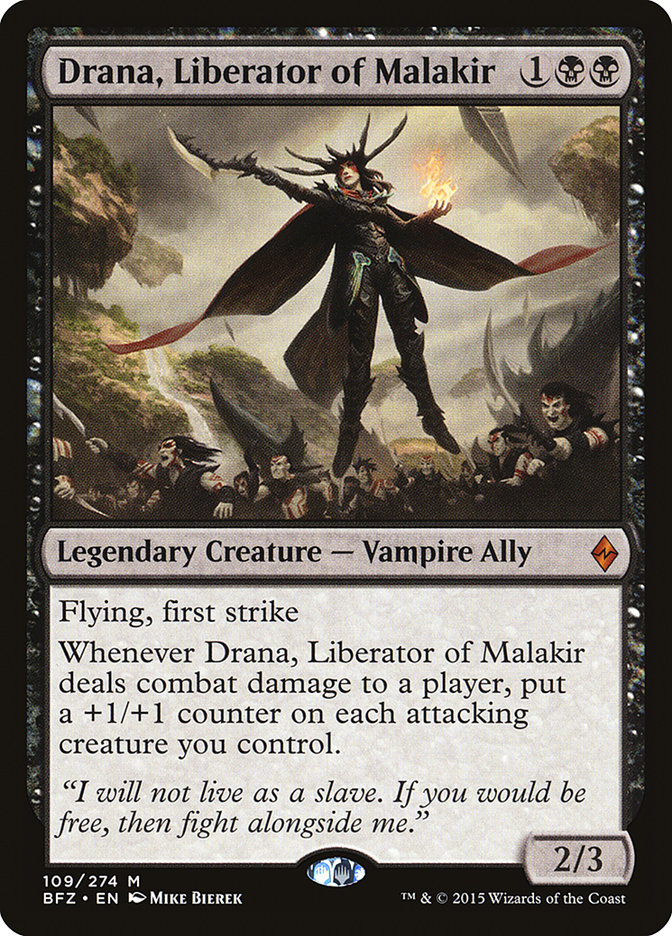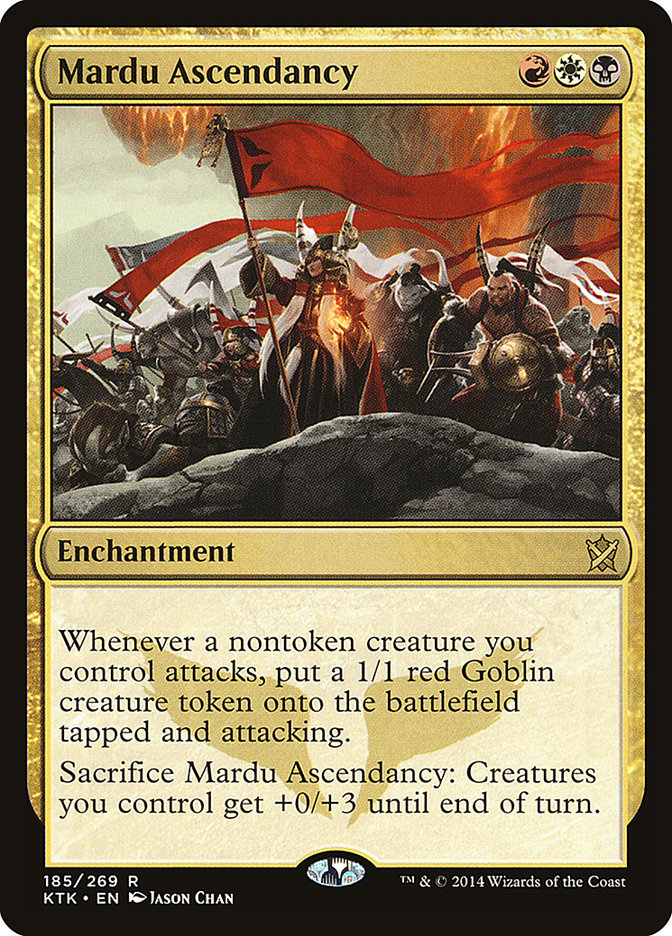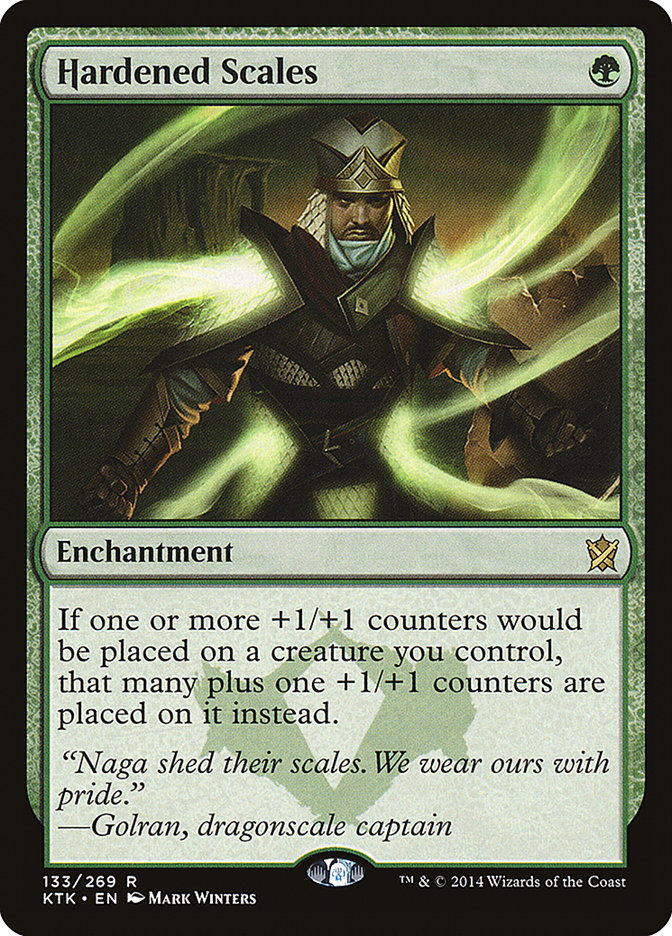While I have written about several cards that have piqued my interest for the new Standard format, the greatest of these is Drana, Liberator of Malakir.
With the rotation of Bile Blight and Lightning Strike, the 2/3 body is particularly well-sized for the format, and the value left behind after an attack or
two is substantial. The fact that the counters Drana grants are placed before most creatures deal combat damage is an underrated bonus that will make
combat all the more difficult for your opponent.
For a three mana investment, you get so much out of this card, and there are several possible homes for it with what is available in Battle for Zendikar Standard. As we examine the possible homes for Drana, I’ll analyze why these decks are best suited for maximizing its power.
First, it is clear that Drana is meant for aggressive strategies. In particular, to get the most value from its ability, it is best to have already
developed your board with some creatures that can get counters as soon as Drana can attack. The more creatures the better, so ideally we are looking for a
swarm aggro deck with plenty of one-mana creatures. Playing three creatures on the first two turns followed by a Drana will make your turn 4 attack
devastating if your opponent cannot kill it.
As far as swarm aggro decks go, nothing seems more appropriate than B/W Warriors:
Creatures (28)
- 4 Chief of the Edge
- 4 Bloodsoaked Champion
- 2 Battle Brawler
- 2 Mardu Shadowspear
- 4 Mardu Woe-Reaper
- 3 Blood-Chin Rager
- 2 Dragon Hunter
- 3 Kytheon, Hero of Akros
- 4 Drana, Liberator of Malakir
Planeswalkers (3)
Lands (23)
Spells (6)

Blood-Chin Rager and Chief of the Edge provide valuable payoff for committing to the Warriors theme, and we would have a heavy number of them anyway with
the quality of the aggressive Warriors in these colors. The only non-Warrior creatures in the deck, Drana and Kytheon, fit so well into the swarm aggro
concept that they are worth playing off-theme.
With fifteen one-mana creatures, we should be able to consistently come out quickly to make our Dranas and Kytheons effective. The mana could be awkward
given that we have mostly white one-drops and a double black three-drop, hence my inclusion of Mardu Shadowspear, but the dual lands available give us
nineteen sources of white and eighteen sources of black, while twelve of the white sources enter the battlefield untapped on turn 1.
We also have access to Shambling Vent, which while being great with Drana by adding a free extra creature to any attack beginning on turn 4, also lets us
increase our land count a bit to make our color situation better and enable us to increase our curve to include the incredibly powerful Gideon, Ally of
Zendikar.
Gideon provides us a great way to stay competitive into the mid-game, develop our board in the face of sweepers, and punish a stumble from our opponents by
making an emblem. It is possible that Brutal Hordechief is a more appropriate four-drop for the deck, but Gideon’s power cannot be ignored and is certainly
worth trying.
The sideboard, as with all of the decks I present today, is geared toward fighting Esper Dragons, Jeskai, Abzan, and Atarka Red variants, all of which I
expect to be significant parts of the early metagame. Note that as a first pass, the sideboards will likely undergo much change over time so they should
only be taken as examples of what is possible.
Having considered Brutal Hordechief for the B/W Warriors list, I felt like there was more potential to use it and Drana in a B/R shell using the powerful
token makers: Dragon Fodder and Hordeling Outburst.
Creatures (22)
- 4 Bloodsoaked Champion
- 4 Monastery Swiftspear
- 1 Battle Brawler
- 4 Brutal Hordechief
- 2 Mardu Shadowspear
- 3 Zurgo Bellstriker
- 4 Drana, Liberator of Malakir
Lands (21)
Spells (17)
Sideboard

This deck has some seriously explosive turns since the token makers can represent six, nine, and even more damage when combined with Drana and Brutal
Hordechief. On top of that, the impressive number of haste creatures, when including dash, means that even if you land Drana or Brutal Hordechief on a
relatively small board, you are still threatening an incredible amount of damage.
Note that while dash does not allow our creature to grow over time, I am less concerned about that since you should be using the mechanic mainly as a way
to close out the game, and the immediate damage increase, while slight, is more important in those scenarios.
This explosive potential means that one or two cards can force a sweeper from your control opponent, and your tokens are more valuable than those in Atarka
Red, especially when considering the lifegain from Brutal Hordechief. We also still retain the capability to go underneath the midrange decks and force
them to play rather conservatively or risk dying on the spot.
To supplement the high damage output capability of the deck, the removal package focuses more on burn spells than the black removal, so we have plenty of
reach to finish games. This deck should thrive in a format that has lost a lot of its best cheap, instant speed removal as well as many early sweepers for
tokens.
With my train of thought on tokens, I focused in on an underutilized card from Khans of Tarkir that plays very well with Drana:
Because of how Drana is worded, the tokens from Mardu Ascendancy enter at the perfect time to receive +1/+1 counters and deal the extra damage that they
represent. So with only one creature on the battlefield in addition to Drana, Mardu Ascendancy represents four power in haste creatures that stay on the
battlefield permanently and continue to grow.
Creatures (28)
- 4 Chief of the Edge
- 4 Bloodsoaked Champion
- 2 Kolaghan, the Storm's Fury
- 3 Mardu Shadowspear
- 3 Zurgo Bellstriker
- 1 Kytheon, Hero of Akros
- 4 Forerunner of Slaughter
- 3 Dust Stalker
- 4 Drana, Liberator of Malakir
Lands (24)
Spells (8)

With more lands that enter the battlefield tapped, I tried to cut down more on one-drops for this list, and instead focused on being able to play above the
Ascendancy with haste creatures. Forerunner of Slaughter, Dust Stalker, and Kolaghan make excellent follow-ups to the Ascendancy, allowing us to improve
our token output. Kolaghan even pumps them if you stack your triggers properly, and it makes for an excellent follow up to the powerful Drana-Ascendancy
curve.
The dash creatures contribute even more to this, and I can certainly see draws where you dash several creatures with an Ascendancy on the battlefield and
generate a huge amount of damage from few resources.
Chief of the Edge gets the nod here because it plays well with most of our one-mana creatures as well as the tokens from Mardu Charm. It is possible that
you could commit further to the Goblins theme by playing Goblin Glory Chaser and Goblin Piledriver, but with no synergy between Mardu Charm and Dragon
Fodder/Hordeling Outburst, I do not think that would work in this shell. Perhaps in the straight B/R shell.
It may seem strange to see a Mardu deck without the full four Nomad Outpost, but I think the creature-lands are powerful enough that you have to play
several copies of one if possible and the format will speed up to the point where you cannot play that many lands that enter the battlefield tapped,
especially if you have Battle lands that require a fair number of basics.
With several options in the Mardu subset of colors, I looked outside of those for possible synergies with Drana and found one that is quite powerful on
paper: Hardened Scales.
Creatures (25)
- 2 Anafenza, the Foremost
- 2 Den Protector
- 4 Avatar of the Resolute
- 2 Servant of the Scale
- 4 Honored Hierarch
- 4 Managorger Hydra
- 4 Hangarback Walker
- 3 Drana, Liberator of Malakir
Lands (24)
Spells (11)
Sideboard

There are plenty of +1/+1 counter synergies to play with Hardened Scales. It is likely that they will have to be scaled back to some extent, trimming the
less effective ones for more generically powerful cards (somehow I don’t think those Siege Rhinos will stay in the sideboard…), but I like to start with
decks that maximize on their internal synergies so you can gather the most information possible in the early stages of testing. In particular, Hangarback
Walker is excellent in this deck, ramping very quickly into a huge threat that many decks will have few answers to or dying and providing a small army for
Drana to quickly turn into a large one with the help of Hardened Scales.
Here we see Drana in a different role than in the Mardu decks. In those lists, we focused on going wide and developing the biggest board possible to
maximize how many counters we receive from each trigger. Here we are still increasing our counter output but in a way that builds our board up rather than
wide, creating a small army of ludicrously huge creatures.
The advantage here is that we are not forced to have a huge board on the first few turns to prepare for Drana, although we retain some potential for those
curves. A curve such as Hardened Scales into Hangarback Walker into Drana, Liberator of Malakir will leave us with a 4/4 that our opponent will be loath to
put in the graveyard and a 4/5 flier after a successful attack–an attack which deals a healthy six damage.
I have opted to not play Abzan Falconer, which could be a mistake if the deck does not have enough ways to break a board stall, but I think between the
aforementioned Hangarback Walker, Avatar of the Resolute, and Managorger Hydra being a huge trample threats, and Den Protector getting harder to block as
it gets larger, I think we have enough without playing a card that is fairly weak in terms of immediate impact unless you already have a substantial board.
Importantly, Den Protector lets you rebuy certain pieces of the engine; whether it is a Hardened Scales you lost to Dromoka’s Command, an Abzan Charm to
grow your creatures, or an extra threat. Whenever you build your deck around synergies like this one, you need ways to ensure you draw your pieces in the
right proportion. Den Protector is perfect for that.
I have opted for Valorous Stance in the sideboard as a way to kill big creatures because it can also protect Managorger Hydra or Drana from removal spells,
which puts the opponent under incredible amounts of pressure. Retreat from Kazandu sits in the last sideboard slot because it is an intriguing option to me
in this deck. It can function as a lifegain spell against red decks but is likely worse than Feed the Clan in that role, but with Hardened Scales it can
quickly grow your board against midrange decks too.
As someone who enjoys attacking, I look forward to breaking out tons of dice during testing to find out which of these homes for Drana is best. There are
certainly more possibilities than the ones I have listed here, most notably an Allies deck since Drana has that creature type as great bonus.
Aggressive decks seem poised to break out of the aggressive red shells that formed the vast majority of these types of decks in Theros/Khans of Tarkir Standard, and Drana is a huge reason why. With any luck I will be happily registering the full four at Pro Tour Battle for
Zendikar in three weeks.





